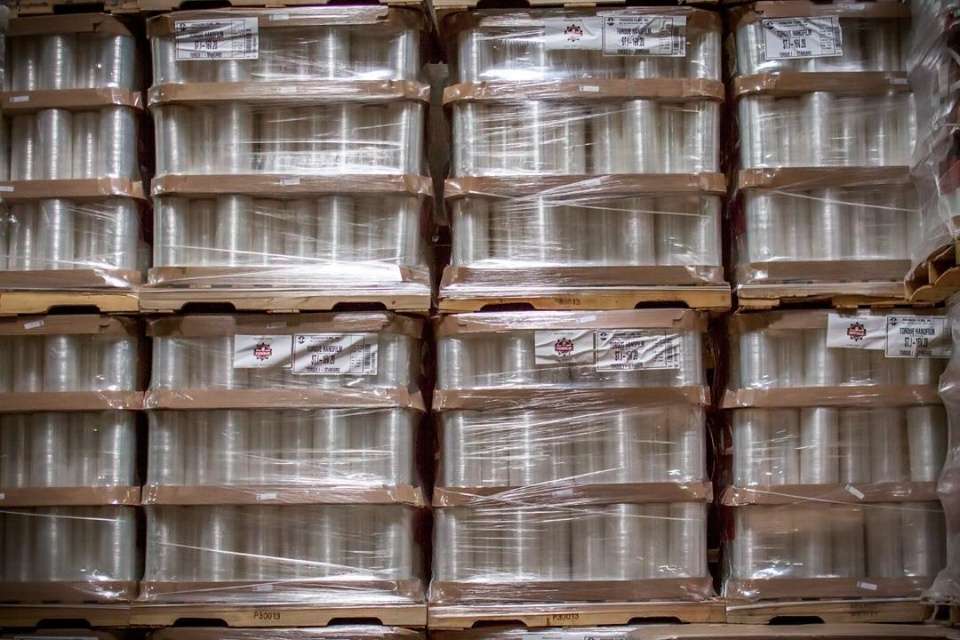Stretch film is an essential part of the packaging process, securing the pallet to the load. It is elastically wrapped around the pallet and is resistant to tearing and protects the goods from the weather and dirt.
But which stretch film should you choose to ensure that your pallet will stand the test of time?
The right questions to ask yourself first when choosing a stretch film
Before discussing the different types of stretch film that exist, ask yourself these necessary questions..
- What types of loads should it cover?
- Are my goods susceptible to crushing, deformation, expansion or shrinkage?
- What is the weight of the pallet?
- What is the shape of the pallet: regular, irregular?
- What visual protection against theft/covetousness?
Your answers will determine the choice of stretch film: quality, strength, colour, etc.

Which stretch film to choose?
The colour of the stretch film
- Black film provides UV protection for 6 months and discretion for packaged goods.
- Black/white opaque film provides even greater discretion. Protecting pallets with black opaque film reduces the visibility of products and does not draw the eye to what is stored. This is very useful for expensive computer products for example.
- Transparent film: This protects the pallets while allowing the goods to be seen.
- Coloured films: there are a variety of colours: yellow, red, green..
The quality of the stretch film: it comes in three different models
Cast three-layer stretch film: highly stretchable and resistant, this film is made of Cast three-layer polyethylene. It also exists in a pre-stretched three-layer version.
Blown stretch film: this high-quality film is well suited to pallets with protruding corners, for example. It has great mechanical strength and is also highly resistant to low temperatures and aggressive handling. It unwinds silently.
Pre-stretched blown film: strong, economical and suitable for a wrapping machine without a pre-stretching system, this film is very easy to use. Already pre-stretched in both directions, it allows less film to be used for the same surface coverage: it makes up to 10 more pallets per day than a conventional film.
It also needs to be reloaded less often and takes up on average 50% less storage space.

Manual or automatic filming?
Stretch film can be used manually or automatically with thehelp of machines.
1.Manual filming: you start filming from the bottom and work your way up to the top before closing the film.
The risks of manual wrapping
However, this manual filming work has been identified by the French health insurance fund as one of the most dangerous tasks, generating a large number of MSDs (musculoskeletal disorders) in France.
“In the smallest companies, the activity of manually wrapping pallets exposes employees to the risk of MSDs when the employee films the ends of the pallet, with his back bent or his arm outstretched, and the risk of falls from the ground due to a lack of visibility or height for large pallets” (Health Insurance).
To counter this problem, and if you do not have automatic machines, a Filmeuse+ aid is offered to SMEs by the Health Insurance. 50% of the purchase price, it allows you to buy one or more rotary tray wrapping machines, rotating arm wrapping machines or automatic covers.
2.Automatic wrapping: it requires much less effort and can be carried out using various machines:
- Turntable wrapping machines : automatic or semi-automatic, these machines are suitable for wrapping standard size pallets and can cover regular and not very fragile loads. Different models are available depending on the company’s needs: industrial wrapping machines for wrapping up to 150 pallets per day or smaller models requiring less space and for more modest palletising needs;
- The wrapping machine with a turntable and automatic arm: attached to one of the corners of the pallet, the turntable turns the arm that wraps the film. It allows complete automatic palletising and only requires the top knot to be cut off once the operation is complete. These wrapping machines are versatile: they cover 100% of wrapping requirements (homogeneous pallets or pallets with sharp corners, large or small loads, products that are sensitive to crushing, etc.). They are automatic and can be programmed, requiring almost no human intervention. This machine needsa fixed area to carry out palletising: it is capable of wrapping between 20 and 30 pallets per day.
- The banding robot: intuitive, easy to use and requiring little space, this robot films pallets from 50 kg without weight or size limitations.

Why choose a banding robot on wheels?
Rolling robots are generally used in adjoining areas where pallet wrapping is not the main activity for shipping packages.
In this case, the pallet shipment takes place in the afternoon, corresponding to the setting up of a workshop and a specific schedule for pallet making. You can then take out your specialised robot for this task.
The choice of stretch film must therefore respect a certain number of criteria depending on the characteristics of the pallet: valuable goods to be protected, manual or automatic palletisation, etc.
The three key points to remember :
- Ask the right questions before choosing your stretch film: weight, shape, pallet protection, etc
- Choose your stretch film according to whether it is to be wrapped manually or automatically.
- Choose the quality of the film in relation to the goods and the pallet as well as the function of the film: securing, visual protection and during transport on a pallet truck, etc















